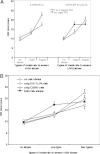Polymorphisms in CRHR1 and the serotonin transporter loci: gene x gene x environment interactions on depressive symptoms
- PMID: 20029939
- PMCID: PMC2924813
- DOI: 10.1002/ajmg.b.31052
Polymorphisms in CRHR1 and the serotonin transporter loci: gene x gene x environment interactions on depressive symptoms
Abstract
Gene x environment (G x E) interactions mediating depressive symptoms have been separately identified in the stress-sensitive serotonergic (5-HTTLPR) and corticotropin-releasing hormone (CRHR1) systems. Our objective was to examine whether the effects of child abuse are moderated by gene x gene (G x G) interactions between CRHR1 and 5-HTTLPR polymorphisms. We used an association study examining G x G x E interactions of CRHR1 and 5-HTTLPR polymorphisms and measures of child abuse on adult depressive symptomatology. The participant population (N = 1,392) was African-American, of low socioeconomic status (60% with <$1,000/month family income), and with high rates of childhood and lifetime trauma. Depressive symptoms were measured with Beck Depression Inventory (BDI) and history of Major Depression by Structure Clinical Interview based on DSM-IV (SCID). We first replicated an interaction of child abuse and 5-HTTLPR on lifetime SCID diagnosis of major depression in a subsample (N = 236) of the study population-the largest African-American 5-HTTLPR cohort reported to date. We then extended our previously reported interaction with both a CRHR1 SNP (rs110402) and TCA haplotype interacting with child abuse to predict current symptoms (N = 1,059; P = 0.0089). We found that the 5-HTTLPR S allele interacted with CRHR1 haplotypes and child abuse to predict current depressive symptoms (N = 856, P = 0.016). These data suggest that G x E interactions predictive of depressive symptoms may be differentially sensitive to levels of childhood trauma, and the effects of child abuse are moderated by genetic variation at both the CRHR1 and 5-HTTLPR loci and by their G x G interaction.
Figures



Similar articles
-
Influence of child abuse on adult depression: moderation by the corticotropin-releasing hormone receptor gene.Arch Gen Psychiatry. 2008 Feb;65(2):190-200. doi: 10.1001/archgenpsychiatry.2007.26. Arch Gen Psychiatry. 2008. PMID: 18250257 Free PMC article.
-
Genetic moderation of child maltreatment effects on depression and internalizing symptoms by serotonin transporter linked polymorphic region (5-HTTLPR), brain-derived neurotrophic factor (BDNF), norepinephrine transporter (NET), and corticotropin releasing hormone receptor 1 (CRHR1) genes in African American children.Dev Psychopathol. 2014 Nov;26(4 Pt 2):1219-39. doi: 10.1017/S0954579414000984. Dev Psychopathol. 2014. PMID: 25422957 Free PMC article.
-
Interactive effects of corticotropin releasing hormone receptor 1, serotonin transporter linked polymorphic region, and child maltreatment on diurnal cortisol regulation and internalizing symptomatology.Dev Psychopathol. 2011 Nov;23(4):1125-38. doi: 10.1017/S0954579411000599. Dev Psychopathol. 2011. PMID: 22018085 Free PMC article.
-
The role of rs242941, rs1876828, rs242939 and rs110402 polymorphisms of CRHR1 gene and the depression: systematic review and meta-analysis.Genes Genomics. 2021 Nov;43(11):1339-1349. doi: 10.1007/s13258-021-01133-9. Epub 2021 Jul 19. Genes Genomics. 2021. PMID: 34279801
-
Interactions of childhood maltreatment and genetic variations in adult depression: A systematic review.J Affect Disord. 2020 Nov 1;276:119-136. doi: 10.1016/j.jad.2020.06.055. Epub 2020 Jul 15. J Affect Disord. 2020. PMID: 32697690
Cited by
-
Serotonin transporter 5-HTTLPR genotype moderates the effects of childhood adversity on posttraumatic stress disorder risk: a replication study.Am J Med Genet B Neuropsychiatr Genet. 2012 Sep;159B(6):644-52. doi: 10.1002/ajmg.b.32068. Epub 2012 Jun 12. Am J Med Genet B Neuropsychiatr Genet. 2012. PMID: 22693124 Free PMC article.
-
Treatment-resistant depression: are animal models of depression fit for purpose?Psychopharmacology (Berl). 2015 Oct;232(19):3473-95. doi: 10.1007/s00213-015-4034-7. Epub 2015 Aug 21. Psychopharmacology (Berl). 2015. PMID: 26289353 Review.
-
The CRF system, stress, depression and anxiety-insights from human genetic studies.Mol Psychiatry. 2010 Jun;15(6):574-88. doi: 10.1038/mp.2009.141. Epub 2009 Dec 15. Mol Psychiatry. 2010. PMID: 20010888 Free PMC article. Review.
-
CREB1 gene polymorphisms combined with environmental risk factors increase susceptibility to major depressive disorder (MDD).Int J Clin Exp Pathol. 2015 Jan 1;8(1):906-13. eCollection 2015. Int J Clin Exp Pathol. 2015. PMID: 25755794 Free PMC article.
-
Study on the mechanism of regulating the hypothalamic cortical hormone releasing hormone/corticotropin releasing hormone type I receptor pathway by vibro-annular abdominal massage under the brain-intestine interaction in the treatment of insomnia.Medicine (Baltimore). 2021 May 14;100(19):e25854. doi: 10.1097/MD.0000000000025854. Medicine (Baltimore). 2021. PMID: 34106630 Free PMC article.
References
-
- Arborelius L, Eklund MB. Both long and brief maternal separation produces persistent changes in tissue levels of brain monoamines in middle-aged female rats. Neuroscience. 2007;145(2):738–750. - PubMed
-
- Arborelius L, Owens MJ, Plotsky PM, Nemeroff CB. The role of corticotropin-releasing factor in depression and anxiety disorders. J Endocrinol. 1999;160(1):1–12. - PubMed
Publication types
MeSH terms
Substances
Grants and funding
LinkOut - more resources
Full Text Sources
Medical

